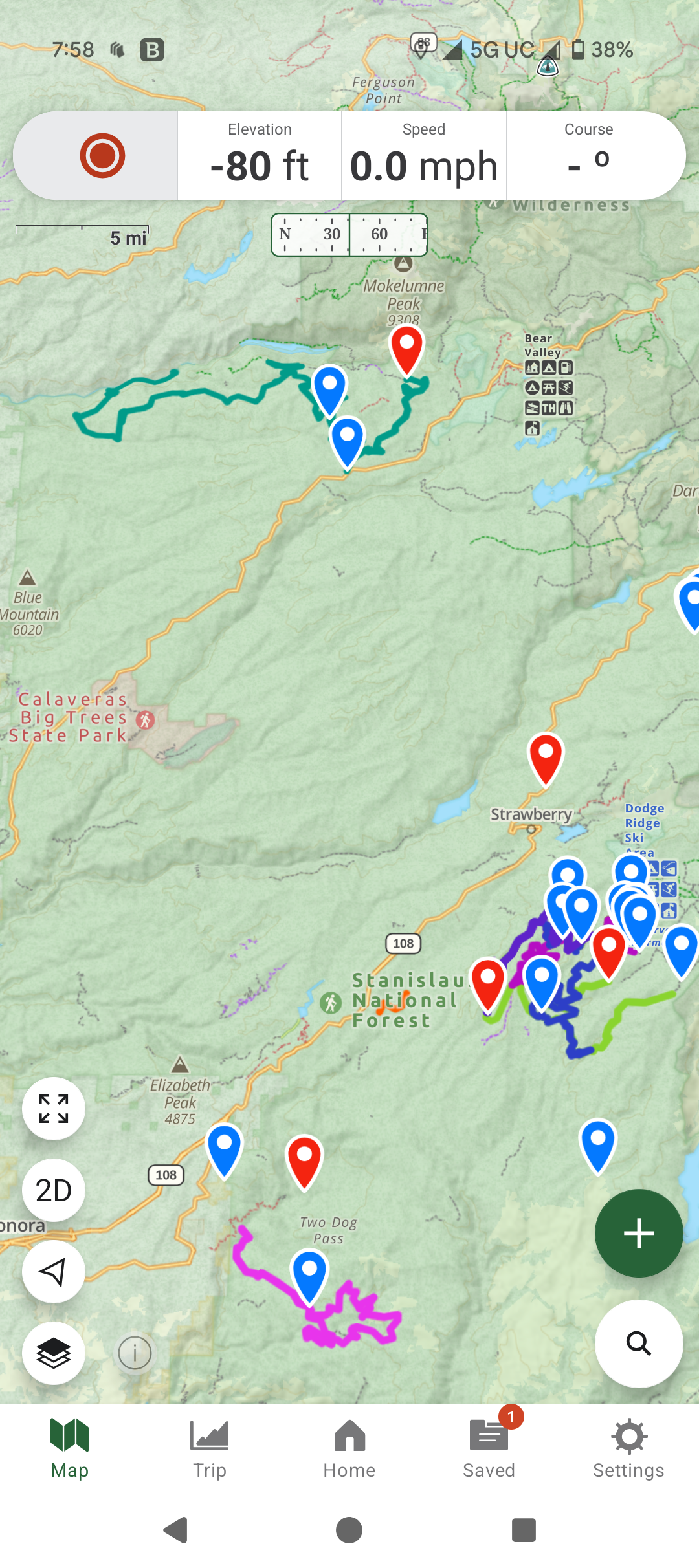Gaia GPS vs. OnX Offroad: A Detailed Comparison
When it comes to off-road navigation, Gaia GPS and OnX Offroad are two of the most popular mapping apps available. Both provide valuable tools for overlanders, off-road enthusiasts, and outdoor adventurers, but they cater to slightly different needs. While OnX Offroad is designed specifically for off-roading with an emphasis on motorized trail navigation, Gaia GPS offers a broader range of mapping features, making it a more customizable and versatile option. Let’s take a deep dive into the differences between these two platforms.
Customization and Map Layers
One of the biggest advantages of Gaia GPS is its extensive customization options. The app allows users to layer multiple map types, including topographic, satellite, USFS (U.S. Forest Service), and land ownership maps. A standout feature in Gaia GPS is the cell phone coverage maps, which display estimated coverage for AT&T, Verizon, and T-Mobile. This is a game-changer for trip planning, as it helps determine if you’ll have any possible cell service or none at all when venturing into remote areas. OnX Offroad, in comparison, offers some customization, but its map layers are more limited compared to Gaia GPS.
Pre-Trip Planning and Syncing
Gaia GPS excels when it comes to pre-trip route planning. Users can plan routes and mark waypoints through a web browser, and the data will automatically sync to mobile devices when the app is opened. However, a WiFi or cellular connection is required for the sync to take place. This makes it easy to plan detailed routes before heading out on a trip and ensures everything is ready to go once in the field. OnX Offroad also allows route planning on a desktop browser, but its synchronization process is less seamless compared to Gaia GPS. OnX is more focused on highlighting pre-existing off-road trails rather than allowing users to create highly customized routes from scratch.
Offline Maps and Navigation
Both apps allow offline map downloads, which is essential for navigating in remote areas without cell service. Gaia GPS offers a more flexible approach to offline maps, allowing users to select specific map layers and regions for download, ensuring access to high-detail topographic, satellite, and road maps even when offline. OnX Offroad also supports offline maps, but the downloading process is more rigid, and users are limited in how much detail they can customize for offline use.
Waypoints and Photo Marking
Both Gaia GPS and OnX Offroad support waypoints, but Gaia GPS provides greater flexibility. Users can mark waypoints with detailed notes, icons, and attach photos to waypoints, making it easier to document important locations such as camping spots, water sources, or obstacles on a trail. OnX Offroad also supports waypoint marking, but its customization options are not as extensive, and photo attachments are not as seamlessly integrated.
Trail Database and Community Integration
Where OnX Offroad shines is in its trail database and off-road community. OnX features thousands of off-road trails with difficulty ratings, user reviews, and trail descriptions. The app is designed to help off-roaders find and navigate pre-existing trails, making it an excellent tool for users looking for pre-vetted off-road routes. While Gaia GPS has some trail databases, it doesn’t match the extensive off-road-specific trail curation that OnX Offroad provides. Instead, Gaia GPS is better suited for users who prefer creating their own routes rather than relying on pre-mapped trails.
User Interface and Ease of Use
Gaia GPS has a steeper learning curve due to its high level of customization. Users who enjoy fine-tuning their maps and layers will appreciate the powerful tools Gaia GPS offers, but newcomers may find it overwhelming at first. On the other hand, OnX Offroad is more beginner-friendly, with a clean interface that prioritizes trail discovery and navigation over deep customization. If you're looking for a simple, ready-to-use off-road mapping tool, OnX Offroad is the better option.
Subscription Pricing and Value
Both Gaia GPS and OnX Offroad require paid subscriptions for full access to their features.
- Gaia GPS Premium costs $39.99 per year, unlocking all map layers, offline downloads, and advanced planning tools.
- OnX Offroad Premium costs $34.99 per year for a single-state map subscription, while the Elite version (which includes all 50 states and land ownership maps) is $99.99 per year.
For users who want nationwide off-road trails and public/private land ownership maps, OnX Offroad’s Elite version is necessary. However, for users looking for advanced mapping and trip-planning tools with greater flexibility, Gaia GPS provides more value at a lower price.
Which One is Best for You?
- Choose Gaia GPS if you need deep customization, pre-trip route planning, and the ability to layer multiple maps. The cell coverage map, combined with offline map options, makes it the superior choice for adventurers who like to plan ahead and customize their navigation experience.
- Choose OnX Offroad if you want an easy-to-use app with a large database of pre-existing off-road trails. The trail ratings, community reviews, and land ownership maps make it a better tool for finding legal and established off-road routes.
Final Verdict
Overall, Gaia GPS is the more powerful and customizable tool, making it ideal for overlanders, backcountry explorers, and off-roaders who prefer building their own routes. OnX Offroad is a great choice for those who primarily stick to mapped trails and want an easy, plug-and-play off-road navigation experience. Each app serves a different purpose, and the best choice depends on whether you prioritize customization (Gaia GPS) or trail discovery (OnX Offroad).


